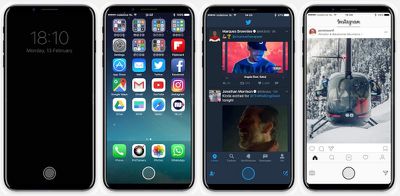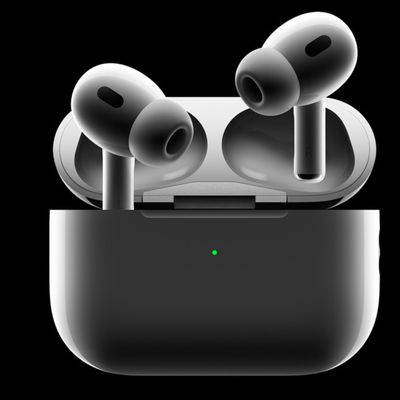'iPhone 8' Could Reportedly Be Called 'iPhone Edition,' Ship Well After 4.7-Inch and 5.5-Inch Versions
Apple may call the 2017 iPhone 8, rumored to be announced alongside the iPhone 7s and 7s Plus at a September event, the "iPhone Edition," according to a new report from Japanese website Mac Otakara. The name would reportedly signal that the phone is a higher end model, similar to how Apple names the Apple Watch Edition. The "Edition" moniker lines up with reports that the model could cost upwards of $1,000.

The report goes on to note that Apple is currently testing multiple prototypes alongside the iPhone 8. The prototypes experiment with screen technology and materials, with some prototypes using an LCD display while others use AMOLED. The prototypes are also in testing with and without home buttons. Further, Apple is using them to test glass, aluminum and white ceramic chassis.
Apple is trying to gauge which materials and technologies they can procure at mass scale for production, according to Mac Otakara. KGI Securities analyst Ming-Chi Kuo, Nikkei and the Wall Street Journal have reported the iPhone 8 will feature an OLED screen, while the 4.7-inch and 5.5-inch lower-end models will sport LCD displays.
Mac Okatara says the only features Apple is reportedly certain of are a 5-inch display, wireless charging and dual cameras. The 5-inch display Mac Otakara is referring to is the usable space on the display. The iPhone 8 is expected to utilize an edge-to-edge display that puts a 5.8-inch display in a handset roughly the size of a 4.7-inch iPhone. 5.15 inches of the 5.8-inch display will be usable. The difference will be used for a wide row of virtual buttons.
The Cupertino company is also expected to announce a more standard 4.7-inch iPhone 7s and 5.5-inch iPhone 7s Plus alongside the "iPhone Edition." According to Mac Otakara, while those two models are expected to launch in September, the "iPhone Edition" may not launch until well after that.
Popular Stories
Apple's next-generation iPhone 17 Pro and iPhone 17 Pro Max are less than three months away, and there are plenty of rumors about the devices.
Apple is expected to launch the iPhone 17, iPhone 17 Air, iPhone 17 Pro, and iPhone 17 Pro Max in September this year.
Below, we recap key changes rumored for the iPhone 17 Pro models:Aluminum frame: iPhone 17 Pro models are rumored to have an...
The long wait for an Apple Watch Ultra 3 appears to be nearly over, and it is rumored to feature both satellite connectivity and 5G support.
Apple Watch Ultra's existing Night Mode
In his latest Power On newsletter, Bloomberg's Mark Gurman said that the Apple Watch Ultra 3 is on track to launch this year with "significant" new features, including satellite connectivity, which would let you...
The upcoming iPhone 17 Pro and iPhone 17 Pro Max are rumored to have a slightly different MagSafe magnet layout compared to existing iPhone models, and a leaked photo has offered a closer look at the supposed new design.
The leaker Majin Bu today shared a photo of alleged MagSafe magnet arrays for third-party iPhone 17 Pro cases. On existing iPhone models with MagSafe, the magnets form a...
The iPhone 17 Pro Max will feature the biggest ever battery in an iPhone, according to the Weibo leaker known as "Instant Digital."
In a new post, the leaker listed the battery capacities of the iPhone 11 Pro Max through to the iPhone 16 Pro Max, and added that the iPhone 17 Pro Max will feature a battery capacity of 5,000mAh:
iPhone 11 Pro Max: 3,969mAh
iPhone 12 Pro Max: 3,687mAh...
iOS 26 and iPadOS 26 add a smaller yet useful Wi-Fi feature to iPhones and iPads.
As spotted by Creative Strategies analyst Max Weinbach, sign-in details for captive Wi-Fi networks are now synced across iPhones and iPads running iOS 26 and iPadOS 26. For example, while Weinbach was staying at a Hilton hotel, his iPhone prompted him to fill in Wi-Fi details from his iPad that was already...
Apple today seeded the second betas of upcoming iOS 18.6 and iPadOS 18.6 updates to public beta testers, with the betas coming just a day after Apple provided the betas to developers. Apple has also released a second beta of macOS Sequoia 15.6.
Testers who have signed up for beta updates through Apple's beta site can download iOS 18.6 and iPadOS 18.6 from the Settings app on a compatible...
Apple's position as the dominant force in the global true wireless stereo (TWS) earbud market is expected to continue through 2025, according to Counterpoint Research.
The forecast outlines a 3% year-over-year increase in global TWS unit shipments for 2025, signaling a transition from rapid growth to a more mature phase for the category. While Apple is set to remain the leading brand by...
Apple is developing a MacBook with the A18 Pro chip, according to findings in backend code uncovered by MacRumors.
Subscribe to the MacRumors YouTube channel for more videos.
Earlier today, Apple analyst Ming-Chi Kuo reported that Apple is planning to launch a low-cost MacBook powered by an iPhone chip. The machine is expected to feature a 13-inch display, the A18 Pro chip, and color options...





















